Copyright ![]() 2001 - Rod Elliott (ESP)
2001 - Rod Elliott (ESP)
Page Last Updated 03 Apr
2001
Transformers - The Details
Section 2

| Elliott Sound Products | Beginners' Guide to Electronics - Part 2 |
Copyright ![]() 2001 - Rod Elliott (ESP)
2001 - Rod Elliott (ESP)
Page Last Updated 03 Apr
2001
Transformers - The Details
Section 2
For those brave souls who have ploughed their way through the first section - I commend you! As you have discovered, transformers are not simple after all, but they are probably far more versatile than you ever imagined. They are, however, real world devices, and as such are prey to the failings of all real components - they are imperfect.
This section will concentrate a little more on the losses and calculations involved in transformer design, as well as explain in more detail where different core styles are to be preferred over others. Again, it is impossible to cover all the possibilities, but the information here will get you well on your way to a full understanding of the subject.
The first topic may seem obvious, but based on the e-mails I get, this is not the case. Transformers can have multiple windings, and these can be on the primary or secondary. Windings can be interconnected to do exciting and different things, but from a safety perspective it is imperative that primary and secondary windings are kept segregated.
There are several references to "shorted turns" within this article. If any two turns of a winding short to each other, the current flow is limited only by the DC resistance of the shorted section of the winding. The current flow is enormous, and with even one shorted turn, the transformer is no longer servicable and must be discarded or rewound. No shield or other conductive material may be wrapped around a core and joined, as this creates a shorted turn capable of possibly hundreds of amperes. The exception to this is the magnetic shield sometimes used with E-I laminated transformers, but this is wrapped around the entire transformer, and is not considered as a "turn" as it is not in the winding window with the primary and secondary.
It is also worth noting that a transformer behaves quite differently
depending upon whether it is driven from a voltage source (i.e. very low
impedance, such as a transistor amp or the mains) or a current source or
intermediate impedance. This will be covered in a little more detail
further on in this article.
| Please note that this is the first draft of this article - expect quite a few corrections and minor changes over the next few weeks. Errors are almost impossible to eliminate until others (and Geoff Moss, who has helped me enormously with previous articles) have had a chance to look them over. Thank you in advance for your understanding. |
Many transformers are supplied with two (or more) secondaries. In many cases, the data sheet will indicate that the windings may be connected in parallel or series. For example, a toroidal transformer may be rated at 2 x 25V at 5A (250VA). With the windings in parallel, the available current is 10A, but only for a single voltage of 25V AC. Connect the windings in series, and you get 50V at 5A, or by referencing the centre tap to earth, the familiar 25-0-25 designation.

Figure 8.1 - Windings
in Series and Parallel
There are some rules that apply to winding interconnections - if you break them, you may break your transformer as well. Note the dots on the windings - this is the traditional way to identify the start of a winding, so that the phase may be determined.
Antiphase wiring will not harm a transformer when wired in series (although the zero volts output for equal windings is somewhat limited in usefulness). Parallel antiphase connection will destroy the transformer unless the fuse blows - which it will do mightily. Always use a fuse when testing, as a simple mistake can be rather costly without some form of protection for the transformer and house wiring!
Windings may be connected in series regardless of voltage. The maximum current available is the rating specified for the lowest current winding. Windings may be connected so as to increase or decrease the final voltage. For example, dual 25V windings may be connected so as to produce 50V or zero volts - although the latter is not generally useful :-)
When windings are connected in phase the voltages add together, and if connected out of phase, they subtract. A 50V, 1 amp winding and a 10V 5 amp winding may therefore be connected to provide any of the following ...
Parallel connection of transformer windings is permitted in one case only - the windings must have exactly the same voltage output, and must be connected in phase. Different current capacities are not a problem, but it is rare to find a transformer with two windings of the same voltage but different current ratings.
Even a 1V difference between winding voltages will cause big problems. A typical winding resistance for a 5A winding might be 0.25 ohm. Should two such windings be connected in parallel, having a voltage difference of 1V, there will be a circulating current limited only by the resistances of the windings. For our example, the total winding resistance is 0.5 ohm, so a circulating current of 2A will flow between the windings, and this is completely wasted power. The transformer will get unexpectedly hot, and the maximum current available is reduced by the value of the circulating current.
Should the windings be connected out of phase, the circulating current will be possibly 100A or more, until the transformer melts or the fuse blows. The latter is generally to be preferred.
The transformer manufacturer's specifications will indicate if parallel operation is permitted. If you are unsure, measure the voltages carefully, and avoid parallel connection if the voltages differ by more than a couple of hundred millivolts. There will always be a difference, and only the manufacturer's winding tolerances can predict what it will be. With toroidal transformers, the windings are often bifilar, meaning that the two windings are wound onto the transformer core simultaneously. The tolerance of such windings is normally very good, and should cause no problems.
In Section 1, I described a very basic push-pull valve output stage. Now it is time to examine this a little more closely. We shall use the same voltages as were obtained in the basic description of Section 1 - an RMS voltage of 707V. It must be said that the following is not intended to be an accurate representation of valves, as the losses in real life are somewhat higher than indicated here. This is for example only. We shall also take the (typical) losses as 10%, and adjust the secondary impedance accordingly.
A valve (tube) amplifier is required to drive an 8 ohm loudspeaker. The primary impedance (called the Plate-Plate impedance for a push-pull amplifier) is 6,000 Ohms, and the supply voltage is 600V. Allowing for losses of 100V across each valve, the maximum voltage swing on the plates (anodes) of the valves is 1kV p-p (or effectively 2kV peak to peak on the transformer primary). What is the output power?
Secondary impedance will be 7.2 ohms, based on the 10% loss ...
![]() Zs
= 8 / 1.1 = 7.2 ohms
Zs
= 8 / 1.1 = 7.2 ohms
The impedance ratio is calculated first ...
![]() Z
= 6,000 / 7.2 = 833
Z
= 6,000 / 7.2 = 833
The turns ratio may now be determined
![]() N
=
N
= ![]() 833 = 28.8 (29:1)
833 = 28.8 (29:1)
The voltage ratio is the same as the turns ratio, so the peak to peak
voltage to the speaker is
![]() Vs
(p-p) = Vp / N = 2,000 / 29 = 69V
Vs
(p-p) = Vp / N = 2,000 / 29 = 69V
To convert this to RMS ...
![]() Vp
= 1/2 Vp-p = 34.5V
Vp
= 1/2 Vp-p = 34.5V
![]() RMS
= peak * 0.707 = 24V
RMS
= peak * 0.707 = 24V
![]() Power
is therefore 242 /
8 = 72W
Power
is therefore 242 /
8 = 72W
Notice that at each calculation, the figures were rounded to the closest (or next lowest) whole number. This was for convenience, but the way I did it also gives a conservative rating that is more likely to be met in practice.
Ouch! Sorry, that was a bit nasty for this time of day :-)
A bit nasty or not, it is a reasonable representation of the reality of an output transformer design, but naturally real (as opposed to my "invented" figures) will be substituted. Typically the losses across the output valves will often be far greater than indicated here. but that depends on the valves used (and the topology - triodes behave very differently from pentodes or tetrodes).
Just to complete this section and to put the above into perspective,
I have included a few figures (taken from the 1972 Miniwatt Technical Data
manual) for the EL34/ 6CA7 power pentode - quite possibly my all-time favourite
output valve.
| Class | Mode * | Plate Volts |
Plate Current |
Screen Volts |
Screen Current |
Grid Bias |
Load Impedance |
Power Output |
Comments |
| Class-A | S-E | 250 | 100 | 265 | 15 | -13V | 2,000 | 11W | Plate supply = 265V, THD** 10% |
| Class-AB | P-P | 375 | 2 x 75 ## 2 x 95 |
365 | 2 x 11.5
2 x 22.5 | -19V | 3,400 (p-p) # | 35W | Cathode bias resistor 130 ohms, common screen resistor, 470 ohms, THD 5% |
| Class-B | P-P | 775 | 2 x 25 2 x 91 |
400 | 2 x 3.0
2 x 19 | -39V | 11,000 (p-p) | 100W | Plate supply, 800V, THD 5% |
| Class-A (Triode) |
S-E | 375 | 70 | - | - | -25V | 3,000 | 6W | Cathode bais resistor 370 ohms, Screen tied to plate, 400V plate supply, THD 8% |
| Class-AB (Triode) |
P-P | 400 | 2 x 65 2 x 71 |
- | - | -28V | 5,000 (p-p) | 16W | Screen tied to plate, Cathode bias resistor 220 ohms, THD 3% |
| * | S-E: Single Ended, P-P: Push-Pull | |
| ** | THD - Total Harmonic Distortion (this is for the valves only, and does not include transformer distortion) | |
| # | p-p: Plate to Plate impedance | |
| ## | First figure is no load, second figure is full power |
As can be seen quite readily, the distortion of the S-E configurations is much worse than the push-pull versions. Not only that, but (to maintain relevance :-) the transformers are larger and harder to design, and even then will be worse than their push-pull counterparts. In the maximum efficiency configuration, power output is 100W, and distortion is still lower than for either of the single ended configurations. The losses across the output valve in this mode are about 58V, but are considerably higher for any of the cathode baised versions - as one might expect.
This will be revisited in another article on the design of valve amplifiers - expect this about mid 2001
It is very important that the core does not saturate (see below), since there will be no variation of flux, no back EMF, and excessive current will be drawn - especially at no load. The final design of any transformer is a huge compromise, and there is a fine line between a transformer that will give acceptable regulation and one that gets too hot to touch at no load.
Somewhat surprisingly, the flux density in the core actually decreases with increased load current drawn from the secondary. Even though the primary is drawing more current, this is transferred to the secondary and thence the load - it does not cause the flux density to increase. The flux density decreases largely due to primary resistance, which causes the effective primary voltage to decrease. Any voltage lost to resistance (remember Ohm's law?) is voltage that is "lost" to the transformer, and serves no function in the transformation process. It does cause the transformer to get hot (or hotter) than at no load.
Also, the normal variation of mains voltage must be allowed for. A transformer running at the very limit of saturation at nominal supply voltage will overheat if the mains is at the upper (normal) limit. A transformer that is designed to run at the limit will have superior regulation compared to a more conservative design, but this is of little consequence if it fails in normal use.
For audio transformers, there are even more compromises.
As discussed earlier, a transformer is a real component, and therefore has losses. These are divided into two primary types, but there are other "hidden" losses as well. All losses reduce efficiency, and affect frequency response. The low frequency limit is determined by the primary inductance, and this is proportional to the area (and consequent mass) of the transformer core. High frequency losses are caused by eddy currents in the core (see below), and by leakage inductance and winding capacitances.
None of these can be eliminated, but by careful selection of core material, winding style and operational limits, they can be reduced to the point where the transformer is capable of doing the job required of it.
Core losses are partly the result of the magnetising current, which must keep forcing the magnetic field in the core to reverse in sympathy with the applied signal. Because the direction of flux is constantly changing, the transformer core is subject to a phenomenon called hysteresis, shown in Figure 11.1
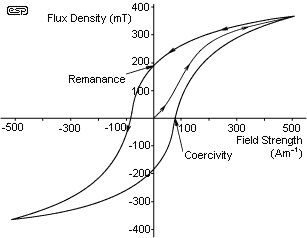
Figure 11.1 - The Hysteresis
Loop
When the magnetomotive force is reversed in a magnetic material, the residual magnetism (remanence - also known as remnance) in the core tries to remain in its previous state until the applied flux is too great (coercivity). It will then reverse, and the same situation will occur twice for each cycle of applied AC. The power required to force the flux to change direction is the hysteresis loss, which although usually small, is still significant. I am not about to go into great detail on this, but a Web search will no doubt reveal more information than you will ever need.
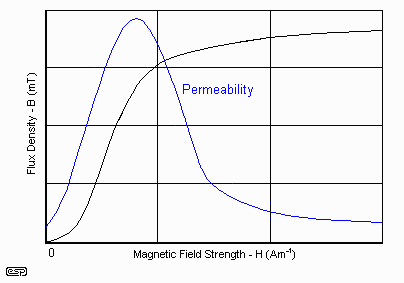
Figure 11.2 - B-H Curve
As can be seen from the two magnetic field drawings, the flux density (B) is dependent upon the applied magnetic field strength (H). For the example shown, the "knee" of the curve coincides with the point where permeability starts to fall. Above this, a progressively larger change in the magnetic field is required to increase the flux density. This is saturation, and most transformers will be designed to operate at or below the knee. Above the knee is dangerous, as a small increase in applied voltage will not produce the required increase in back EMF, and the primary current will increase disproportionately to the rise in voltage. In other words, the transformer will be too sensitive to applied voltage, and will possibly self destruct if the mains voltage were even slightly higher than normal.
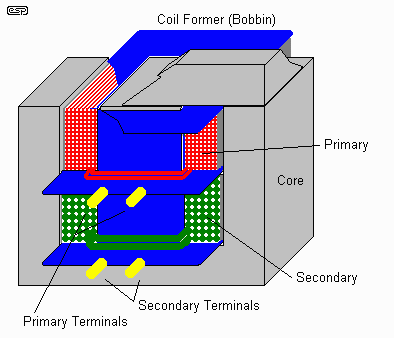
Figure 11.3 - Cutaway
View of a Transformer
The transformer shown is a "split bobbin" type, having separate sections on the former for the primary and secondary windings. This reduces the capacitance between windings, and also provides a safety barrier between the primary and secondary. For some applications, this is the only winding method that meets safety standards. It is also very simple to add an electrostatic shield between the windings - a flat plate of thin metal is cut so that it can be slipped over the bobbin, and the ends are insulated so that it does not create a shorted turn. This is connected to earth, and prevents noise from being capacitively coupled between windings. The shield would logically be placed on the secondary side of the bobbin divider for safety.
In addition, there are so-called "eddy current" losses. These are small circulating currents within the magnetic core, as shown (exaggerated) in Figure 11.4, and these cause the core material itself to get hot. Each of these eddy current loops acts as a tiny shorted turn to the transformer, and to reduce the effect, the core is laminated - i.e. made from thin sheets of steel, insulated from each other. The thinner the laminations, the smaller are the eddy current losses, but they will never be eliminated. Eddy current losses increase with frequency, requiring different techniques for high frequency operation, and are the major contributor to the iron losses in any transformer.
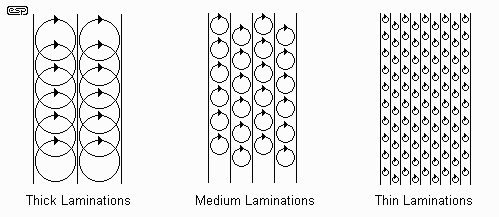
Figure 11.4 - Eddy Currents
in Laminations
The eddy currents are shown for three lamination thicknesses. Although not shown (for the sake of clarity), the current loops are constantly overlapping, and are effectively infinite in number. The thick laminations allow the loops to be larger, and therefore the lamination section is cut by more magnetic "lines" of force, so the currents (and losses) are larger. For high frequencies (above 10kHz), it is generally not possible to make laminations thin enough to prevent the losses from becoming excessive, and ferrite materials are preferred. These effectively have a huge number of incredibly small magnetic particles, all insulated from each other, and eddy current loops are very small indeed. Even so, ferrite materials are normally specified up to a few hundred kilo-Hertz for power applications, before the losses become too great again.
Iron losses of both types are the primary source of losses in any transformer that is operating at no load or only light loading.
You will see that in Figure 11.3 the windings are shown stacked directly on top of each other. Surely a more efficient winding can be made by making use of the "valleys", minimising the winding height and allowing heavier windings. Ah, if only life were that simple! The windings are traditionally made from left to right, then right to left, so the turns in each layer are at a slight angle relative to the layer below or above. It is therefore not possible to interleave the windings properly, and if you were to design a transformer based on the erroneous assumption that interleaving would work, the winding would not fit into the window.
For the normal layered construction (i.e. primary closest to the core, and secondary over the top), we also have to allow for insulation between primary and secondary, and in some cases additional insulation is used between layers of larger transformers because of the large voltage difference between the outer limits of each winding. These are another set of compromises that must be made, all of which mean that the windings must be thinner than we might like, and thus the losses are increased.
Because any length of wire has resistance, there will always be winding resistance. The greater the resistance for a given current, the more power is dissipated as heat - this is a complete loss. At no load, there is virtually no loss, since the currents are low, but as secondary current increases, so too do the copper losses.
Copper loss is the primary source of loss at any appreciable power from a transformer. Conventional rectifiers as used in semiconductor amplifier power supplies cause the resistance to be more significant than would otherwise be the case. See Linear Power Supply Design for more details on these losses.
Copper loss is responsible for a transformer's regulation - the ratio of voltage at no load versus full load. Regulation is almost always specified into a resistive load, which considering the way nearly everyone uses transformers, is virtually useless. It is rare that any transformer is operated into a purely resistive load - the vast majority will be used with a rectifier and filter capacitors, and the manufacturer's figure is worthless. Actually, it is worse than worthless, as it misleads the uninitiated to expect more voltage than they will obtain under load, and causes people grief as they try to work out why their amplifier (for example) gives less power than expected.
Naturally, there are some to whom any measurement is sacrilege, so none
of this applies to them ![]()
The output voltage is (nearly) always specified at full load into a resistance. So a 50V, 5A transformer will give an output of 50V at a sinewave output current of 5A. If the regulation of this transformer were 4%, what is the no-load voltage?
The answer is 52V. Regulation is determined quite simply from
the formula ...
![]() Reg%
= ( VN - VL
) / VL * 100 / 1
Reg%
= ( VN - VL
) / VL * 100 / 1![]() Where
VN
is no-load volts, and VL
is loaded volts
Where
VN
is no-load volts, and VL
is loaded volts
As determined earlier, this assumes a sinusoidal output current, and this just does not happen with a rectifier / filter load. It may be found that this same transformer has an apparent regulation of 8 to 10% when supplying such a load. See Linear Power Supply Design for more information on this topic (there is little point in doing the article twice :-)
The regulation with rectifier loads is a complex topic, but you will need to know the ramifications before you start construction of your latest masterpiece, rather than find out later that all your work has resulted in much lower output power than you expected. Not that you can change it for any given transformer, but at least you will know what to expect.
Since the transformer is not an ideal device, it has unwanted properties apart from the losses described so far. The other losses are relatively insignificant for a power transformer, but become difficult to manage for transformers intended for wide bandwidth, such as microphone transformers and valve output transformers.
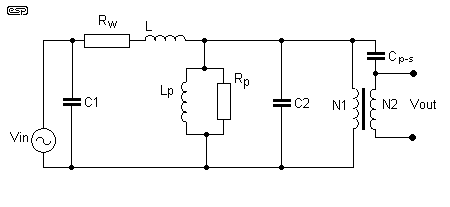
Figure 11.5 - Transformer
Simplified Equivalent Circuit
The equivalent circuit shown in Figure 11.5 is greatly simplified, but serves to illustrate the points. Since the windings are usually layered, there must be capacitance (C1 and C2) between each layer and indeed, each turn. This causes phase shifts at high frequencies, and at some frequency, the transformer will be "self resonant". This is not a problem with power transformers, but does cause grief when a wide bandwidth audio transformer is needed.
In addition, there is some amount of the magnetic field that fails to pass through both windings. This creates a "leakage" inductance (L) that is effectively in series with the transformer. Although small, it tends to affect the high frequencies in particular, and is especially troublesome for audio output transformers. This is typically measured with an inductance meter, with the output winding short circuited. Any inductance that appears is the direct result of leakage flux.
Lp is the primary inductance, and as you can see, there is a resistor in parallel (Rp). This represents the actual impedance (at no load) presented to the input voltage source, and simulates the iron losses. The series resistance (Rw) is simply the winding resistance, and is representative of the copper losses.
Cp-s is the inter-winding capacitance, and for power transformers can be a major contributor to noise at the output. This is especially irksome when the transformer is supplying a hi-fi system, and mains borne noise gets through and makes horrid clicks, electronic "farts", electric motor whine, and various other undesirable noises in the music. Toroidal transformers are very much worse than conventional (E-I) transformers in this respect, because of the large area of each winding. An electrostatic shield will all but eliminate such noises, but these are expensive and uncommon with toroids (pity).
The capacitance between the primary and secondary can become troublesome with this technique, and although possible, an electrostatic shield (actually, a number of electrostatic shields are needed) adds considerably to the cost, but creates a minimal overall benefit. This winding method is not used (or needed) with low frequency power transformers, and would lead to greatly reduced electrical safety because of the difficulty of insulating each section from the next. This latter problem also exists with an output transformer, but is easier to control because one side of the secondary is earthed.
Another problem exists when the capacitance between primary and secondary is high - electrical noise on the primary is coupled through the capacitance to the secondary. This can lead to mains noise getting through the entire power supply and into the amplifier in extreme cases. To combat this problem, an electrostatic shield is sometimes used, and this is connected to earth. Note that the shield cannot be joined in a complete circle around the winding, as this would create a shorted turn that would draw a tremendous current and burn out the transformer.
There is a technique that is used for valve output transformers, shown in Figure 11.6 - you will not find this method used in power transformers, as it is completely unnecessary.
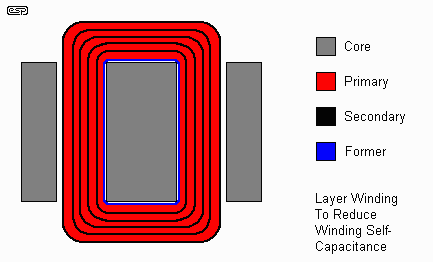
Figure 11.6 - Interleaved
Winding for Extended HF Response
The trick to winding transformers to minimise the winding leakage inductance and self capacitance is called "interleaving", but this results in much greater inter-winding capacitance (between primary and secondary). The most common way this is done is to use a multi-segmented winding, as shown in the sectional drawing of Figure 11.6. This type of winding is (or was) quite common for high quality valve output transformers, and the extension of frequency on the top end of the audio spectrum is very noticeable.
I measured the characteristics of a small selection of transformers
to give some comparative data. I excluded regulation from this, as
it is difficult to make a suitable load at short notice, and loads tend
to get rather hot even with short usage. Most manufacturers will
provide this information in their specifications, but be warned that this
refers to a resistive load, and regulation will be much worse when
supplying a conventional rectifier and filter capacitor (see above, and
the Power Supply Design article for more details). It is also worth
noting that an inductance meter is often of little use with large iron
cored transformers, unless it operates with a sinusoidal waveform at (or
near) the design frequency of the transformer. The inductances shown
are calculated, since the measured values with my meter were a long way
off.
| Type | Rating | Inductance | Resistance | Turns/Volt | Magnetising | Core Loss | Reactance | Mass (kg) |
| Toroidal | 500VA | 34.7 H | 2R4 | 2 | 22mA | 5.28W | 10.91k ohms | 5.0 |
| Toroidal | 200VA | 63 H | 5R1 | 3 | 12mA | 2.88W | 20k ohms | 2.7 |
| E-I | 200VA | 4.36 H | 6R6 | 2 | 175mA | 42W | 1.37k ohms | 3.2 |
The toroidals are clear winners in terms of core loss in particular, but it must be said that the E-I transformer tested is not really representative of the majority. This is one of a few left that I had specially made, and they were deliberately designed to push the saturation limits of the core. These transformers run quite hot at no load, but give much better regulation than a more conservative design - the vast majority of such transformers. They were actually designed to run just above the "knee" of the B-H curve for the laminations used, and although somewhat risky, none has failed (to my knowledge) since they were made about 20 years ago. I use a pair of them in my hi-fi system, which has been in daily use for 10 years now.
It is also worth noting that the mass is lower than for a more "traditional" transformer design - a conventional design of the same power rating would be expected to weigh in at about 5kg.
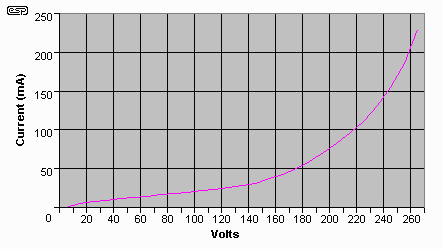
Figure 12.1 - Current
vs. Voltage for the E-I Transformer
To take my measurements to the logical limit, I measured the magnetising current of my sample E-I transformer. Look closely at the graph in Figure 12.1, and you will see a typical BH curve (as shown in Figure 11.2 but with the axes reversed). As you can see, at 240V input, the transformer is operating at the knee of the curve, and is well on the way to saturation. There was no point doing this for the toroidals, as they are operated well below saturation level and I would be unable to (conveniently) measure them.
Toroids usually have a more pronounced knee, and a correspondingly steeper rise in current once the saturation limit has been reached. This is primarily because of the fully enclosed magnetic path, which has no air gaps at all (E-I laminated transformers have a small but significant gap where the laminations are joined. This is unavoidable in any practical transformer, but has little affect on performance in real life.
There is a huge array of different core shapes, and each has its own advantages and disadvantages. The two most common for commercial and DIY audio equipment are the E-I "shell" core and the toroidal core, but there are many others.
Ferrites in particular are moulded, and therefore have many specialised shapes to suit various applications, as well as the more traditional shapes shown below.
Toroidal cores are made from a continuous strip grain oriented silicon steel, and are bonded to prevent vibration and maximise the "packing density". It is important that there are no gaps between the individual layers, which will lower the performance of the core. The sharp corners are rounded off, and they are usually coated with a suitable insulating material to prevent the primary (which is always wound on first) from contacting the core itself.
I don't propose to even attempt them all, but one iron core that warrants special mention is the "C" core. These were once very popular, but have lost favour since suitable winding machines became available for toroids. They are still a very good core design, and are especially suited where an intrinsically safe transformer is required (i.e. where the primary and secondary windings are physically separated), and this technique also ensures that the inter-winding capacitance is minimal. C-cores are made by rolling a continuous strip into the desired shape, and after bonding, it is cut in half. To ensure the best possible magnetic coupling (i.e. no air gap), the cut ends are machined and polished as a pair - it is very important to ensure that the two are properly mated, or unacceptable losses will occur. The core halves are commonly held together with steel banding, similar to that used for large transport boxes.
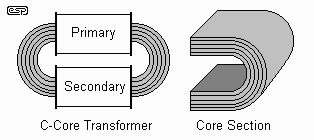
Figure 13.1 - C-Core
Transformer
A sample of ferrite cores is shown in Figure 13.2 - this is but a small indication of the selections available, and most styles are also available in many different grades to suit specific applications.

Figure 13.2 - Some Ferrite
Core Styles
The diagram in Figure 13.3 shows the correct way to stack an E-I transformer. Sometimes manufacturers will use 2 or 3 laminations in the same direction, then the same in the other. This cuts costs, but the transformer performance will never be as good. Alternate laminations minimise the air gap created between the E and I sections due to imperfect mating of the two. It is essential that the laminations are packed as tightly as possible so that the effects of the air gaps are minimal.

Figure 13.3 - E-I Lamination
Stacking
When a transformer using E-I laminations is bolted together, it is important that the bolts are insulated from the core. If not, this would allow large eddy currents to circulate through the end laminations and the bolts, reducing performance dramatically. For safety, the core should always be bonded to mains earth unless the transformer is rated as "double insulated".
"Yes, but what good is that? The laminations are insulated from each other anyway." The inter-lamination insulation is sufficient to prevent eddy currents, but cannot withstand the mains voltage, so in case of electrical breakdown, the core may become "live" if not earthed.
In order to reduce the radiated flux from an E-I transformer core, you will sometimes see a copper or brass band* wrapped around the winding and the outside of the core, as shown in Figure 13.4. This acts as a shorted turn to the leakage flux only, and greatly reduces magnetic interference to adjacent equipment. Such measures are not needed with toroidal transformers, as leakage flux is very much lower, and the core is completely enclosed by the windings.
(* While I am sure that many people would love to see their local brass band wrapped around a transformer, this is not what I had in mind. It does create an interesting mental picture though :-)
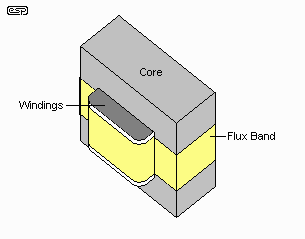
Figure 13.4 - Flux Banded
Transformer
Just in case you were wondering, the dimensions of E-I laminations are worked out so that the laminations can be created with no material waste (other than the holes). The relative dimensions are shown below, and are just a ratio of the real dimensions, which will naturally be in millimetres or inches.
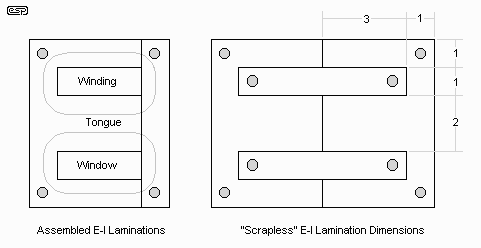
Figure 13.5 - Assembled
Laminations and Punching Dimensions
The magnetic path length is the average for the dual path shown in the assembled lamination drawing, and is generally assumed to be 12. This may be thought a little pessimistic, but is the commonly accepted figure. The winding window size is restricted by the punching dimensions, and it is critical that the maximum usage is made of the limited area available. Should the winding wire be too thin, there will be plenty of room, but copper losses will be excessive. Make the winding wire too thick, and the completed winding will not fit into the available space. Additional space must be allowed for the winding bobbin, and for inter-winding insulation and the final insulation layer.
DC flows in the windings for any transformer that is used for "flyback" switching supplies or SET power amplifiers, to name but two. The effect is that the DC creates a magnetomotive force that is unidirectional, and this reduces the maximum AC signal that can be carried before saturation in one direction. Indeed, the DC component may cause saturation by itself, so the transformer would be rendered useless as a means of passing the AC signal without severe degradation. Even the use of a half wave rectifier will introduce an effective DC component into the windings, and these should be avoided at any significant power level (i.e. more than a few milliamps).
To combat this, transformers that are subject to DC in the windings use an air gap in the core, so it is no longer a complete magnetic circuit, but is broken by the gap. This lowers the inductance, and means that a larger core must be used because of the reduced permeability of the core material due to the gap. An air gap also increases leakage inductance because of the flux "fringing" around the gap, and resistive (copper) losses are increased as well, because more turns will be needed.
It is beyond the scope of this article to cover this in great detail, but it does impose some severe restrictions on the design of transformers where DC is present. This is (IMO) one of the biggest disadvantages of the SET amplifier so popular with audiophiles, as it almost invariably leads to unacceptable compromises and equally unacceptable distortion (both harmonic and frequency).
In some designs, it is possible to eliminate the DC component by using a tertiary winding that carries ... DC. If the additional winding can be made to induce a flux that is equal and opposite that of the bias current, then the quiescent flux in the transformer can be reduced to zero (where it belongs). The disadvantage with this is that it requires an extra winding, and that takes up valuable winding space on the core. It is also a difficult technique to get right, and is not often seen these days. It was a popular technique in telecommunications equipment at one time, and meant that smaller transformers could be used for the same (or better) performance.
E-I transformers all have a minuscule "air gap" because of the way the laminations are assembled. With care, this can be almost be considered negligible, but it cannot be eliminated. C-cores will have their cut ends machined to minimise the effect, but again, it cannot be eliminated entirely. The toroidal core has no air gap at all, and is therefore more efficient (magnetically speaking) - they are utterly intolerant of DC in the windings.
There is an enormous range of core materials, even within the same basic class, so I will mention only a few of the most common. All materials have some basic requirements if they are to be used with AC (for transformers, rather than solenoids or relays, which can operate with DC). The core cannot be solid and electrically conductive, or excessive eddy current will flow, heating the core and causing very high losses. Therefore, all cores use either thin metal laminations, each electrically insulated from the next, or powdered magnetic material in an insulating filler. The list below is far from exhaustive - there are a great many variations of alloys, and I have mentioned only a few of those that are in common use.
Silicon Steel (General Information)
Typically, soft (i.e. low remanence) magnetic steel will contain about
4% to 4.5% silicon, which lowers the remanence of the steel and reduces
hysteresis losses. Normal mild steel, carbon steel or pure iron has
quite a high remanence, and this is easily demonstrated by stroking a nail
(or screwdriver) with a magnet. The nail will become magnetised,
and will retain enough magnetism to enable it to pick up other nails.
The addition of silicon reduces this effect, and it is very difficult to
magnetise a transformer lamination strongly enough so it can pick things
up.
This is not to say that the remanence is zero - far from it. When a transformer is turned off, there will often be residual magnetism in the core, and when next powered on, it is common for the transformer to make noise - both toroids and E-I transformers can sometimes make a "boing" noise when power is applied. That this phenomenon is intermittent is a combination of several factors ...
Silicon steel and other metal (as opposed to ferrite) materials are normally annealed by heating and then cooling slowly after stamping and forming. This removes most of the internal mechanical stresses caused by the stamping or rolling operation(s) - these stresses reduce the magnetic properties of the material, sometimes very dramatically.
CRGO - Cold Rolled Grain Oriented Silicon Steel
Like many steels, this version is cold-rolled to obtain the required
thickness and flatness needed for a transformer core. The magnetic
"grain" of the steel is aligned in one direction, allowing a higher permeability
than would otherwise be possible. This material is ideal for toroids
and C-cores, since the grain can be aligned in the direction of magnetic
flux (i.e. in a circular pattern around the core). It is less suited
to E-I laminations, because the flux must travel across the "grain"
at the ends of the lamination, reducing permeability.
CRNGO - Cold Rolled Non Grain Oriented Silicon Steel
Generally more suited to E-I laminations, this is essentially the same
process as the CRGO, but the magnetic grain is left random, with no alignment
of the magnetic domains. Although this reduces overall permeability,
the effective permeability will be better with stamped laminations (as
opposed to rolled, as with toroids and C-cores).
Powdered Iron
A soft ferrite ceramic material, used where there is significant DC
in the winding. Powdered iron cores have relatively low permeability
(about 90, maximum), and are designed for high frequency operation.
These cores are most commonly used with no air-gap, and will not saturate
easily. Typically used as filter chokes in switching power supplies,
and as EMI (Electro-Magnetic Interference) filters - the toroid is the
most common shape.
Ferrite
Soft ferrites are the mainstay of switching power supplies, and low
level high speed transformers (such as might be used for network interface
cards and small switching transformers. Ferrites are available with
outstanding permeability, which allows small cores with very high power
capability. Flyback (a type of switchmode operation) transformers
in particular are usually gapped because of the DC component in the primary
current.
High permeability ferrites are also very common in telecommunications and for other small audio frequency transformers where very high inductance and small size is required.
MuMetal
Named after the symbol for permeability, as one might expect, this
material has an extraordinarily high permeability - typically in the order
of 30,000. It is commonly used as magnetic shielding for cathode
ray tubes in high quality oscilloscopes, screening cans for microphone
transformers, and as laminations for low level transformers. The
maximum flux density is quite low compared to other metallic materials.
Apart from being relatively soft, if dropped, the magnetic properties may
be adversely affected (MuMetal requires careful annealing to ensure that
its magnetic properties are optimised).
An ideal transformer has zero distortion, but there are zero ideal transformers. Therefore, it can be deduced that transformers do have distortion, but how much?
The answer depends entirely on how the transformer is used. When supplied from a voltage source of zero ohms impedance, the real life transformer has no distortion, but again, there is no such thing as zero ohms (actually, it can be done, but yields little real benefit).
Any transformer operating at low flux density, and with a low impedance source, will contribute very little distortion to the signal. As frequency decreases, and/ or operating level increases, the limits of saturation will eventually be reached in any transformer, and distortion will become a problem. This is not really an issue with mains power transformers, but is very important for valve output transformers, particularly at low frequencies.
The distortion characteristics of transformers used as valve output devices is a complex subject, and will not be covered here. Suffice to say that the normal methods of determining the turns per volt, based on the bare minimum lowest frequency response will give unacceptably high distortion levels at low frequencies.
Although interesting, the relationships are complex and will be of little real use to the majority of hobbyists. If there is sufficient interest, I may cover this in a later article.
Countless different books and Web pages were researched during the compilation of this article, and although some were interesting, the majority were of minimal use. Of those who I actually remember (a daunting task in itself, considering the sheer amount of searching I had to do), I must "thank" the following Web pages (in alphabetical order) ...
The following (edited) definitions are from Units of Measurement
Units of Measurement site copyright by Russ Rowlett and
University of North Carolina at Chapel Hill.
Definitions used by permission.
tesla (T) - flux density (or field intensity) for magnetic fields (also called the magnetic induction). The intensity of a magnetic field can be measured by placing a current-carrying conductor in the field. The magnetic field exerts a force on the conductor which depends on the amount of the current and the length of the conductor. One tesla is defined as the field intensity generating one newton of force per ampere of current per meter of conductor. Equivalently, one tesla represents a magnetic flux density of one weber per square meter of area. A field of one tesla is quite strong: the strongest fields available in laboratories are about 20 teslas, and the Earth's magnetic flux density at its surface, is about 50 microteslas (µT). One tesla equals 10,000 gauss. The tesla, defined in 1958, is named after Nikola Tesla (1856-1943), whose work in electromagnetic induction led to the first practical generators and motors using alternating current (much to the annoyance of Edison, who claimed DC was "safer").
weber (Wb) - magnetic flux. "Flux" is the rate (per unit of time)
in which something crosses a surface perpendicular to the flow. In the
case of a magnetic field, then the magnetic flux across a perpendicular
surface is the product of the magnetic flux density, in teslas, and the
surface area, in square metres. If a varying magnetic field passes
perpendicularly through a circular loop of conducting material (one turn),
the variation in the field induces a electric potential in the loop.
If the flux is changing at a uniform rate of one weber per second, the
induced potential is one volt. This means that numerically the flux
in webers is equal to the potential, in volts, that would be created by
collapsing the field uniformly to zero in one second. One weber is the
flux induced in this way by a current varying at the uniform rate of one
ampere per second. The unit honours the German physicist Wilhelm
Eduard Weber (1804-1891), one of the early researchers of magnetism.
This list is far from complete, but will be sufficient to either get you started or scare you away. I have included the symbols and units of only three of the entries below, since most are of no real interest.
Coercivity - is the field strength which must be applied to reduce (or coerce) the remanant flux to zero. Materials with high coercivity (e.g. those used for permanant magnets) are called hard. Materials with low coercivity (those used for transformers) are called soft. Coercivity is the "reverse" of remanence.
Effective Area - of a core is the cross sectional area of the centre limb for E-I laminations, or the total area for a toroid. Usually this corresponds to the physical dimensions of the core but because flux may not be distributed evenly the manufacturer may specify a value which reflects this.
Effective Length - of a core is the distance which the magnetic flux travels in making a complete circuit. Usually this corresponds closely to the average of the physical dimensions of the core, but because flux has a tendency to concentrate on the inside corners of the path the manufacturer may specify a value for the effective length.
Flux Density - (symbol; B, unit; teslas (T)) is simply the total flux divided by the effective area of the magnetic circuit through which it flows.
Flux Linkage - in an ideal inductor the flux generated by one turn would be contained within all the other turns. Real coils come close to this ideal when the other dimensions of the coil are small compared with its diameter, or if a suitable core guides the flux through the windings.
Magnetomotive Force - MMF can be thought of as the magnetic equivalent of electromotive force. It is the product of the current flowing in a coil and the number of turns that make up the coil.
Magnetic Field Strength - (symbol: H, unit; ampere metres (A m-1)) when current flows in a conductor, it is always accompanied by a magnetic field. The strength, or intensity, of this field is proportional to the amount of current and inversely proportional to the distance from the conductor (hence the -1 superscript).
Magnetic Flux - (symbol: ![]() ;
unit: Webers (Wb)) we refer to magnetism in terms of lines of force or
flux, which is a measure of the total amount of magnetism.
;
unit: Webers (Wb)) we refer to magnetism in terms of lines of force or
flux, which is a measure of the total amount of magnetism.
Permeability - (symbol; µ, units: henrys per metre (Hm-1) is defined as the ratio of flux density to field strength, and is determined by the type of material within the magnetic field - i.e. the core material itself. Most references to permeability are actually to "relative permeability", as the permeability of nearly all materials changes depending upon field strength (and in most cases - especially in ferrites - with temperature as well).
Remanence - (or remnance) is the flux density which remains in a magnetic material when the externally applied field is removed. Transformers require the lowest possible remanence, while permanant magnets need a high value of remanence. Remanence is the "reverse" of coercivity .